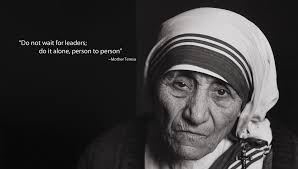"The hunger for love is much more difficult to remove than the hunger for bread.” Mother Teresa
 "Do not wait for leaders..."www.theblackvault.com The 1900’s was a time encapsulated in war. It seemed that all corners of the earth was experiencing defeat. With the world at the hands of violence and hatred, perhaps there was no hope. Whether or not she knew it, Agnes Gonxha Bojaxhiu would become a beacon of light in a time that needed it most. Agnes was born in Skopje, Yugoslavia, on August 27, 1910. From a young age, she was taught the values of unconditional love and hospitality. Parents, Nikola and Drana actively gave to the poor, including those seeking refuge from surrounding countries. Reality was filled with destruction, however, “during the war years, at least for Agnes, family and the church community seemed like a pocket of calm and happiness” (Tilton 17). Eighteen years later as part of Loreto Sisters, Agnes would take the title Mother Teresa. Standing at just above five feet, Mother Teresa was a complete depiction of ‘don’t judge a book by it’s cover’. She appeared petite and fragile, but later became a powerful influence. She was a motherly figure that showed the world there is no wrong in pursuing your call and creating purpose in life. Driven by passion, Mother Teresa fought to remain her authentic self and lived life with the utmost intent.
"Do not wait for leaders..."www.theblackvault.com The 1900’s was a time encapsulated in war. It seemed that all corners of the earth was experiencing defeat. With the world at the hands of violence and hatred, perhaps there was no hope. Whether or not she knew it, Agnes Gonxha Bojaxhiu would become a beacon of light in a time that needed it most. Agnes was born in Skopje, Yugoslavia, on August 27, 1910. From a young age, she was taught the values of unconditional love and hospitality. Parents, Nikola and Drana actively gave to the poor, including those seeking refuge from surrounding countries. Reality was filled with destruction, however, “during the war years, at least for Agnes, family and the church community seemed like a pocket of calm and happiness” (Tilton 17). Eighteen years later as part of Loreto Sisters, Agnes would take the title Mother Teresa. Standing at just above five feet, Mother Teresa was a complete depiction of ‘don’t judge a book by it’s cover’. She appeared petite and fragile, but later became a powerful influence. She was a motherly figure that showed the world there is no wrong in pursuing your call and creating purpose in life. Driven by passion, Mother Teresa fought to remain her authentic self and lived life with the utmost intent.
 She was not a person who looked powerful, but she truly showed it. Pictured: Mother Teresa and Princess Dianahttps://diaryofapmpmom.comMother Teresa represented what it meant to be authentic and unbothered by the world around her. When Mother Teresa gained attention, she kept in mind her own personal values and purpose from the start, serving the less fortunate. She believed that recognition was not needed in return for it was fulfilled when helping others. According to The Importance of Mother Teresa,“[...] she once protested[...] others do the same work as we do. Do it perhaps better. Why single us out?” (Tilton 96). Often, nuns are seen as delicate, but Mother Teresa was tough in the eyes of the people and she had to be. She didn't let lights and cameras dictate her life. Instead, she remained selfless, afterall, it was not about her. Even at times of recognition and reward, it was simply dedicated to God and the poor. To have it her way, meant that fame and awards obtained no value. When asked the question, ‘Do you think that poverty and hunger will ever become extinct?’, Mother Teresa responded, “There’s always enough food, the only thing that is missing is love” (BuildingWithBooks). It is a popular concept to believe that there is not enough resources. Food may be limited, and time, too valuable to waste, but love was another thing. Physical attributes were not essential in this case. Her opinions stood alone and were often questioned. Mother Teresa was convinced that when you gave from the heart, that was enough. Even at a time where love was obsolete, in her eyes, it could cure diseases.
She was not a person who looked powerful, but she truly showed it. Pictured: Mother Teresa and Princess Dianahttps://diaryofapmpmom.comMother Teresa represented what it meant to be authentic and unbothered by the world around her. When Mother Teresa gained attention, she kept in mind her own personal values and purpose from the start, serving the less fortunate. She believed that recognition was not needed in return for it was fulfilled when helping others. According to The Importance of Mother Teresa,“[...] she once protested[...] others do the same work as we do. Do it perhaps better. Why single us out?” (Tilton 96). Often, nuns are seen as delicate, but Mother Teresa was tough in the eyes of the people and she had to be. She didn't let lights and cameras dictate her life. Instead, she remained selfless, afterall, it was not about her. Even at times of recognition and reward, it was simply dedicated to God and the poor. To have it her way, meant that fame and awards obtained no value. When asked the question, ‘Do you think that poverty and hunger will ever become extinct?’, Mother Teresa responded, “There’s always enough food, the only thing that is missing is love” (BuildingWithBooks). It is a popular concept to believe that there is not enough resources. Food may be limited, and time, too valuable to waste, but love was another thing. Physical attributes were not essential in this case. Her opinions stood alone and were often questioned. Mother Teresa was convinced that when you gave from the heart, that was enough. Even at a time where love was obsolete, in her eyes, it could cure diseases.
 The Children of Calcuttawww.youngadultministryinabox.comTo fully understand Mother Teresa’s intent, you must understand Calcutta, India; a place where help was desperately needed: “a vast sea of suffering and misery”. In the slums of Calcutta, “[...] people were born and died hourly, [the streets] were crowded with beggars and lepers, […] Unwanted infants were regularly abandoned and left to die in clinics, on the streets, or in garbage bins” (“Teresa Of Calcutta, Mother”). People went without food and starved. People were poor and disease stricken. People died. Mother Teresa went to those people and she cared for them. She didn’t go to places where she was comfortable. She didn’t stay there for a short period of time, living separately. Instead, she dedicated her life to helping the poor, solely becoming the poor. Once she found her purpose, it manifested into something much more significant. Eventually, Mother Teresa took additional steps in her vocation, strengthening her passion for a career she loved. She had felt that there was more to be done, and more she did: “In 1948 the Vatican gave her permission to leave the Sisters of Loretto and to start a new work[...]”. She left Calcutta for Patna “ [where she] took an intensive medical training with the American Medical Missionary[...]” (“Mother Teresa”). As if she wasn’t doing enough, Mother Teresa continued to fulfill her calling. Her work in Calcutta was now extended to helping the ill and dying, directly. Going out of her own way to contribute to her full extent, represented who she was: a woman who believed life was made to live with ambition. No matter the circumstance, she understood that there could always be more and unlike many, she acted on it. She embodied what it meant to live with purpose by using every breath, action, and spoken word for the greater good.
The Children of Calcuttawww.youngadultministryinabox.comTo fully understand Mother Teresa’s intent, you must understand Calcutta, India; a place where help was desperately needed: “a vast sea of suffering and misery”. In the slums of Calcutta, “[...] people were born and died hourly, [the streets] were crowded with beggars and lepers, […] Unwanted infants were regularly abandoned and left to die in clinics, on the streets, or in garbage bins” (“Teresa Of Calcutta, Mother”). People went without food and starved. People were poor and disease stricken. People died. Mother Teresa went to those people and she cared for them. She didn’t go to places where she was comfortable. She didn’t stay there for a short period of time, living separately. Instead, she dedicated her life to helping the poor, solely becoming the poor. Once she found her purpose, it manifested into something much more significant. Eventually, Mother Teresa took additional steps in her vocation, strengthening her passion for a career she loved. She had felt that there was more to be done, and more she did: “In 1948 the Vatican gave her permission to leave the Sisters of Loretto and to start a new work[...]”. She left Calcutta for Patna “ [where she] took an intensive medical training with the American Medical Missionary[...]” (“Mother Teresa”). As if she wasn’t doing enough, Mother Teresa continued to fulfill her calling. Her work in Calcutta was now extended to helping the ill and dying, directly. Going out of her own way to contribute to her full extent, represented who she was: a woman who believed life was made to live with ambition. No matter the circumstance, she understood that there could always be more and unlike many, she acted on it. She embodied what it meant to live with purpose by using every breath, action, and spoken word for the greater good.
Globally, she was known as a Saint from Ireland, but Mother Teresa proved to be so much more as a result of her authenticity and belief that life was to be filled with intention. Mother Teresa always remained herself despite outside pressures, encouraging others to stay grounded. Her character truly set herself apart from others. Collectively, she was headstrong and inspired many to pursue a purpose in life. Her mission was to help others even if it was a blunt responsibility of mankind. Over her lifetime, Mother Teresa’s humility radiated. She was someone who did not ask for supporters, but was endlessly supported anyway. She didn’t care if her name was known, but today, she is very well heard of. “Mother Teresa never intended to start a movement or establish a dynasty. She cared only that individuals cared for individuals[...] (Tilton 107). It is evident that she had a heart, pure like none other as if it was made by gold itself. At times of war and personal conflict, we are reminded by Mother Teresa to be a light in the midst of darkness.
Page created on 5/24/2018 6:26:36 PM
Last edited 9/3/2021 5:57:43 AM
Works Cited
BuildingWithBooks. “Mother Theresa Interview (1996) -- Part 2.” YouTube, YouTube, 11 July 2008, www.youtube.com/watch?time_continue=18&v=t4X2OQa8_bg.
"Mother Teresa." Encyclopedia of World Biography, Gale, 1998. Biography In Context, https://link.galegroup.com/apps/doc/K1631006438/BIC?u=powa9245&sid=BIC&xid=b14e4bbe.
"Teresa Of Calcutta, Mother." Historic World Leaders, edited by Anne Commire, Gale, 1994. Biography In Context, https://link.galegroup.com/apps/doc/K1616000567/BIC?u=powa9245&sid=BIC&xid=fb3d06c0. Accessed 10 May 2018.
Tilton, Rafael. Mother Teresa. Lucent Books, 2000.
